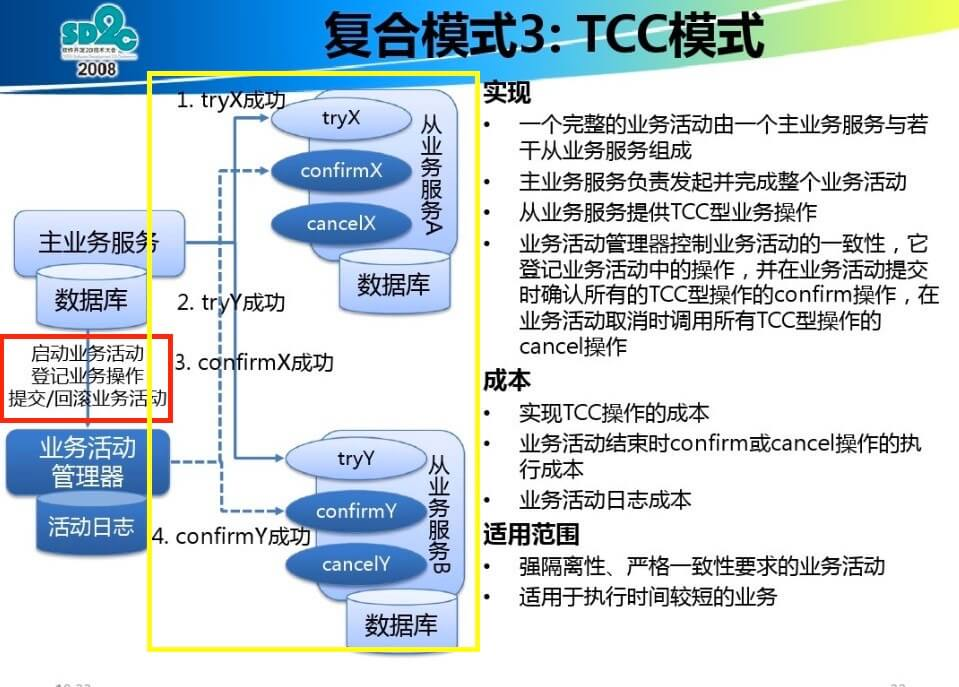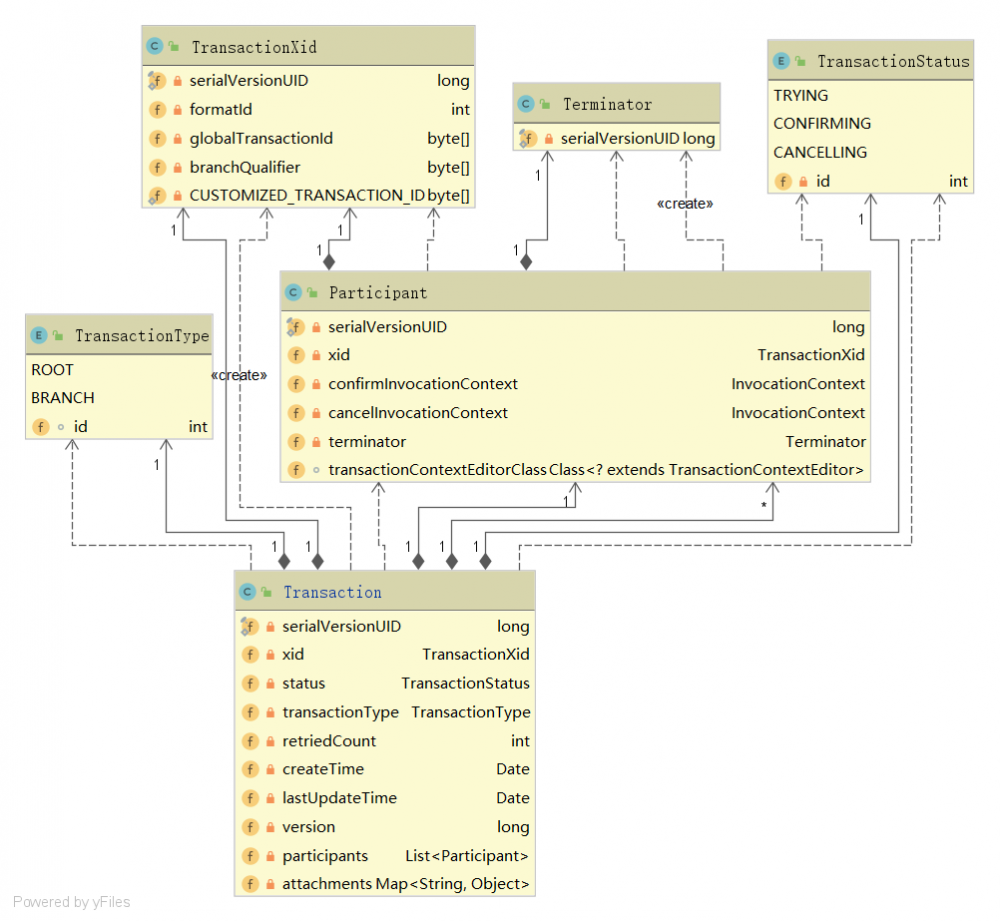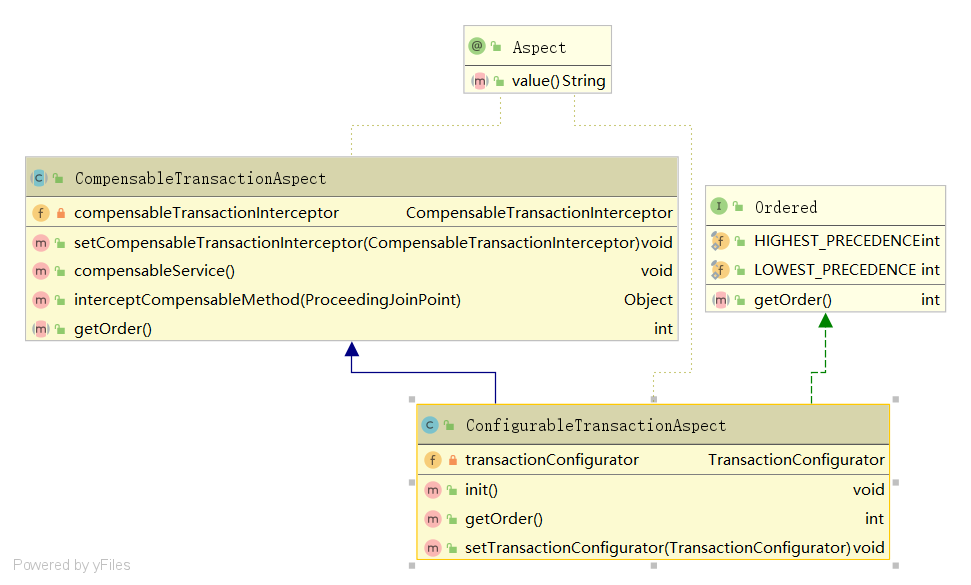TCC-Transaction源码解读。
为了解决在事务运行过程中大颗粒度资源锁定的问题,业界提出一种新的事务模型,它是基于业务层面的事务定义。锁粒度完全由业务自己控制。它本质是一种补偿的思路。它把事务运行过程分成 Try、Confirm / Cancel 两个阶段。在每个阶段的逻辑由业务代码控制。这样就事务的锁粒度可以完全自由控制。业务可以在牺牲隔离性的情况下,获取更高的性能。
- try阶段:
- try:尝试执行业务
- 完成所有业务检查(一致性)
- 预留必须的业务资源(准隔离性)
- try:尝试执行业务
- Confirm / Cancel 阶段:
- Confirm :确认执行业务
- 真正执行业务
- 不做任何业务检查
- confirm操作满足幂等性
- Cancel:取消执行业务
- 释放 Try 阶段预留的业务资源
- Cancel 操作满足幂等性
- Confirm 与 Cancel 互斥
- Confirm :确认执行业务
整体流程如下图:

摘自: www.iocoder.cn/TCC-Transac…
Tcc-transaction原理
在tcc-transaction中,一个tcc事务可以包含多个业务活动,tcc-transaction把每个事务活动都抽象成事务的参与者,每个事务可以包含多个参与者。
我们先看一看tcc-transaction基础架构设计。

事务管理器负责管理事务以及参与者,spring aop的方式在业务前后进行拦截,负责将参与者加入到事务中,并将事务注册进事务管理器,同时将事务存储在事务存储器进行持久化,事务补偿job通过定时检查事务存储器里的事务状态来对事务进行补偿。
显而易见,tcc-transaction入口就是事务拦截器,事务拦截器通过两个切面的方式将所有组件组织在一起。
读源码前置参考

事务
我们先看看Transaction这个类的属性。
/*
* 事务编号
*/
private TransactionXid xid;
/**
* 事务状态
*/
private TransactionStatus status;
/**
* 事务类型
*/
private TransactionType transactionType;
/**
* 重试次数
*/
private volatile int retriedCount = 0;
/**
* 创建时间
*/
private Date createTime = new Date();
/**
* 最后更新时间
*/
private Date lastUpdateTime = new Date();
/**
* 乐观锁控制
*/
private long version = 1;
/**
* 多个参与者
*/
private List<Participant> participants = new ArrayList<Participant>();
// 附带属性映射 用于隐式传参
private Map<String, Object> attachments = new ConcurrentHashMap<String, Object>();
复制代码
其中包含TransactionXid、TransactionStatus、TransactionType以及Participant。
TransactionXid
/**
* xid 格式标识
*/
private int formatId = 1;
/**
* 全局事务编号
*/
private byte[] globalTransactionId;
/**
* 分支事务编号
*/
private byte[] branchQualifier;
复制代码
TransactionStatus
TRYING(1), CONFIRMING(2), CANCELLING(3); 复制代码
TransactionType
/**
* 根事务
*/
ROOT(1),
/**
* 分支事务
*/
BRANCH(2);
复制代码
参与者
/**
* 事务id
*/
private TransactionXid xid;
/**
* confirm方法上下文
*/
private InvocationContext confirmInvocationContext;
/**
* cancel方法上下文
*/
private InvocationContext cancelInvocationContext;
/**
* 执行器
*/
private Terminator terminator = new Terminator();
/**
* 上下文编辑
*/
Class<? extends TransactionContextEditor> transactionContextEditorClass;
public void rollback() {
terminator.invoke(new TransactionContext(xid, TransactionStatus.CANCELLING.getId()), cancelInvocationContext, transactionContextEditorClass);
}
public void commit() {
terminator.invoke(new TransactionContext(xid, TransactionStatus.CONFIRMING.getId()), confirmInvocationContext, transactionContextEditorClass);
}
复制代码
事务管理器
提供事务的获取、发起、提交、回滚,参与者的新增等等方法。
这些先看看,有个印象,下面会详细讲解其中的内容。
事务拦截器
事务拦截器由两个spring aop切面实现,如下图。

我们先来看一看使用示例:
参与者需要声明 try / confirm / cancel 三个类型的方法,和 TCC 的操作一一对应。在程序里,通过 @Compensable 注解标记在 try 方法上,并填写对应的 confirm / cancel 方法。
// try 方法
@Compensable(confirmMethod = "confirmRecord", cancelMethod = "cancelRecord", transactionContextEditor = DubboTransactionContextEditor.class)
public String record(CapitalTradeOrderDto tradeOrderDto) {
}
// confirm方法
public void confirmRecord(CapitalTradeOrderDto tradeOrderDto) {
}
// cancel方法
public void cancelRecord(CapitalTradeOrderDto tradeOrderDto) {
}
复制代码
很明显,肯定是有切面切入了@Compensable:注解的方法,我们先来找一下。 在源码的spring支持中有这么一段配置:
<bean id="transactionConfigurator" class="org.mengyun.tcctransaction.spring.support.:"
init-method="init"/>
<bean id="compensableTransactionAspect" class="org.mengyun.tcctransaction.spring.ConfigurableTransactionAspect"
init-method="init">
<property name="transactionConfigurator" ref="transactionConfigurator"/>
</bean>
<bean id="resourceCoordinatorAspect" class="org.mengyun.tcctransaction.spring.ConfigurableCoordinatorAspect"
init-method="init">
<property name="transactionConfigurator" ref="transactionConfigurator"/>
</bean>
复制代码
SpringTransactionConfigurator是一个配置相关的类,我们先不管。
ConfigurableTransactionAspect
先看看类图:

我们先看看ConfigurableTransactionAspect类。
@Aspect
public class ConfigurableTransactionAspect extends CompensableTransactionAspect implements Ordered {
private TransactionConfigurator transactionConfigurator;
public void init() {
// 设置事务管理器
TransactionManager transactionManager = transactionConfigurator.getTransactionManager();
// 这个是具体的拦截实现类
CompensableTransactionInterceptor compensableTransactionInterceptor = new CompensableTransactionInterceptor();
compensableTransactionInterceptor.setTransactionManager(transactionManager);
compensableTransactionInterceptor.setDelayCancelExceptions(transactionConfigurator.getRecoverConfig().getDelayCancelExceptions());
this.setCompensableTransactionInterceptor(compensableTransactionInterceptor);
}
@Override
public int getOrder() {
// order越小,则优先级越高。
return Ordered.HIGHEST_PRECEDENCE;
}
public void setTransactionConfigurator(TransactionConfigurator transactionConfigurator) {
this.transactionConfigurator = transactionConfigurator;
}
}
复制代码
ConfigurableTransactionAspect继承了CompensableTransactionAspect同时实现了Orderd,且Order值为最小值,这就是我们要找的第一个切面。
这里子类就是给父类提供了初始化,切面具体逻辑在父类。我们看看父类的逻辑。
@Aspect
public abstract class CompensableTransactionAspect {
private CompensableTransactionInterceptor compensableTransactionInterceptor;
public void setCompensableTransactionInterceptor(CompensableTransactionInterceptor compensableTransactionInterceptor) {
this.compensableTransactionInterceptor = compensableTransactionInterceptor;
}
/**
* 切点
*/
@Pointcut("@annotation(org.mengyun.tcctransaction.api.Compensable)")
public void compensableService() {
}
/**
* 切面
* @param pjp
* @return
* @throws Throwable
*/
@Around("compensableService()")
public Object interceptCompensableMethod(ProceedingJoinPoint pjp) throws Throwable {
return compensableTransactionInterceptor.interceptCompensableMethod(pjp);
}
public abstract int getOrder();
}
复制代码
可以看到具体逻辑还是在compensableTransactionInterceptor中,我们继续跟。
public Object interceptCompensableMethod(ProceedingJoinPoint pjp) throws Throwable {
// 获得 具体的方法 注解 传播行为 以及事务上下文
CompensableMethodContext compensableMethodContext = new CompensableMethodContext(pjp);
// 事务是否存在于当前线程中
// transactionManager为单例的,其中包含一个threadlocal , 里面是一个Deque(双端队列)
// 判断该threadlocal里的Deque是否为空
boolean isTransactionActive = transactionManager.isTransactionActive();
// 判断事务上下文是否合法
// 传播级别为支持当前事务 而不支持新事务、同时当前线程中不存在事务,且事务上下文为空
// 则是非法 抛出异常
if (!TransactionUtils.isLegalTransactionContext(isTransactionActive, compensableMethodContext)) {
throw new SystemException("no active compensable transaction while propagation is mandatory for method " + compensableMethodContext.getMethod().getName());
}
// 判断是根事务还是分支事务
// 如果传播级别为必须新开事务 或者 (允许新建事务且线程中不存在事务,且事务上下文为空) 则是根事务
// ----------------------------------------------------------------------------------------------------
// 如果不满足上述条件, 且(事务的传播级别为支持当前事务或者为支持当前事务,并不允许开启事务)并且当前没有活动事务,并且事务上下文不为空
// 则是分支事务
switch (compensableMethodContext.getMethodRole(isTransactionActive)) {
case ROOT:
return rootMethodProceed(compensableMethodContext);
case PROVIDER:
return providerMethodProceed(compensableMethodContext);
default:
// 如果事务存在于线程中 或者事务的传播行为为支持当前事务,没有事务则以非事务执行 则直接执行
return pjp.proceed();
}
}
复制代码
首先获取注解对应的参数。
public CompensableMethodContext(ProceedingJoinPoint pjp) {
this.pjp = pjp;
// 获取到具体方法
this.method = getCompensableMethod();
// 获取到注解
this.compensable = method.getAnnotation(Compensable.class);
// 注解上的传播行为
this.propagation = compensable.propagation();
// 获得事务上下文
this.transactionContext = FactoryBuilder.factoryOf(compensable.transactionContextEditor()).getInstance().get(pjp.getTarget(), method, pjp.getArgs());
}
复制代码
tcc-transaction支持四种传播行为。
/**
* 支持当前事务,如果当前没有事务,就新建一个事务。
*/
REQUIRED(0),
/**
* 支持当前事务,如果当前没有事务,就以非事务方式执行。
*/
SUPPORTS(1),
/**
* 支持当前事务,如果当前没有事务,就抛出异常。
*/
MANDATORY(2),
/**
*新建事务,如果当前存在事务,把当前事务挂起。
*/
REQUIRES_NEW(3);
复制代码
FactoryBuilder是一个抽象的单例工厂,整句话就是从注解的transactionContextEditor.class中获得一个单例得transactionContextEditor,然后调用这个transactionContextEditor的get方法获得事务的上下文。
我们回到interceptCompensableMethod。isTransactionActive判断当前线程是否包含事务。
public boolean isTransactionActive() {
// 从threadLocal里获取双向队列
Deque<Transaction> transactions = CURRENT.get();
return transactions != null && !transactions.isEmpty();
}
复制代码
就是看一下当前线程里的双向队列是否有值。
继续往下走。
// 判断事务上下文是否合法
// 传播级别为支持当前事务而且不支持新事务、同时当前线程中不存在事务,且事务上下文为空
// 则是非法 抛出异常
if (!TransactionUtils.isLegalTransactionContext(isTransactionActive, compensableMethodContext)) {
throw new SystemException("no active compensable transaction while propagation is mandatory for method " + compensableMethodContext.getMethod().getName());
}
复制代码
// 非法的必要条件
public static boolean isLegalTransactionContext(boolean isTransactionActive, CompensableMethodContext compensableMethodContext) {
if (compensableMethodContext.getPropagation().equals(Propagation.MANDATORY) // 事务传播行为为支持当前事务,没有事务则抛出异常
&& !isTransactionActive // 没有当前事务
&& compensableMethodContext.getTransactionContext() == null //事务上下文为空
) {
return false;
}
return true;
}
复制代码
接着走。
switch (compensableMethodContext.getMethodRole(isTransactionActive)) {
// 判断是根事务还是分支事务
// 如果传播级别为必须新开事务 或者 (允许新建事务且线程中不存在事务,且事务上下文为空) 则是根事务
case ROOT:
return rootMethodProceed(compensableMethodContext);
// 如果不满足上述条件, 且(事务的传播级别为支持当前事务或者为支持当前事务,并不允许开启事务)并且当前没有活动事务,并且事务上下文不为空
case PROVIDER:
return providerMethodProceed(compensableMethodContext);
default:
// 如果事务存在于线程中 或者事务的传播行为为支持当前事务,没有事务则以非事务执行 则直接执行
return pjp.proceed();
}
}
复制代码
看一下根事务的处理方法。
private Object rootMethodProceed(CompensableMethodContext compensableMethodContext) throws Throwable {
Object returnValue = null;
Transaction transaction = null;
// 是否同步confirm
boolean asyncConfirm = compensableMethodContext.getAnnotation().asyncConfirm();
// 是否同步cancel
boolean asyncCancel = compensableMethodContext.getAnnotation().asyncCancel();
// 加入延迟cancel相关的异常
Set<Class<? extends Exception>> allDelayCancelExceptions = new HashSet<Class<? extends Exception>>();
allDelayCancelExceptions.addAll(this.delayCancelExceptions);
allDelayCancelExceptions.addAll(Arrays.asList(compensableMethodContext.getAnnotation().delayCancelExceptions()));
try {
// 创建根事务
// 在内存中创建一个事务,声明为根事务
// 将刚刚的事务持久化到redis、zookeeper或者mysql 再或者磁盘
// 将事务注册进transactionManager中的treadlocal中的deque中
transaction = transactionManager.begin(compensableMethodContext.getUniqueIdentity());
try {
// 执行
returnValue = compensableMethodContext.proceed();
} catch (Throwable tryingException) {
// 异常处理
// 如果不是需要延迟的异常类型
if (!isDelayCancelException(tryingException, allDelayCancelExceptions)) {
logger.warn(String.format("compensable transaction trying failed. transaction content:%s", JSON.toJSONString(transaction)), tryingException);
// 立即回滚
// 获取当前线程的deque队头的事务,
// 改变事务状态 并持久化改变的事务状态
// rollback所有参与者
// delete持久化的事务
transactionManager.rollback(asyncCancel);
}
// 抛出异常
throw tryingException;
}
// 提交
// 和上述回滚步骤一致
transactionManager.commit(asyncConfirm);
} finally {
// 将事务从当前线程事务队列移除
transactionManager.cleanAfterCompletion(transaction);
}
return returnValue;
}
复制代码
看一下begin方法。
/**
* 发起根事务
* @param uniqueIdentify
* @return 事务
*/
public Transaction begin(Object uniqueIdentify) {
// 创建根事务
Transaction transaction = new Transaction(uniqueIdentify,TransactionType.ROOT);
// 存储 事务
transactionRepository.create(transaction);
// 注册事务
registerTransaction(transaction);
return transaction;
}
复制代码
private void registerTransaction(Transaction transaction) {
if (CURRENT.get() == null) {
CURRENT.set(new LinkedList<Transaction>());
}
CURRENT.get().push(transaction);
}
复制代码
分支事务的处理方法。
private Object providerMethodProceed(CompensableMethodContext compensableMethodContext) throws Throwable {
Transaction transaction = null;
boolean asyncConfirm = compensableMethodContext.getAnnotation().asyncConfirm();
boolean asyncCancel = compensableMethodContext.getAnnotation().asyncCancel();
try {
// 事务上下问中的状态
switch (TransactionStatus.valueOf(compensableMethodContext.getTransactionContext().getStatus())) {
// 如果是try阶段
case TRYING:
// 传播发起分支
// 在内存中创建一个事务,声明为分支事务,事务id为事务上下文中的事务id
// 持久化事务
// 注册进deque中
transaction = transactionManager.propagationNewBegin(compensableMethodContext.getTransactionContext());
return compensableMethodContext.proceed();
case CONFIRMING:
try {
// 传播获取分支
// 从持久化中取出事务
// 注册进deque中
transaction = transactionManager.propagationExistBegin(compensableMethodContext.getTransactionContext());
transactionManager.commit(asyncConfirm);
} catch (NoExistedTransactionException excepton) {
//the transaction has been commit,ignore it.
}
break;
case CANCELLING:
try {
// 传播获取分支
transaction = transactionManager.propagationExistBegin(compensableMethodContext.getTransactionContext());
transactionManager.rollback(asyncCancel);
} catch (NoExistedTransactionException exception) {
//the transaction has been rollback,ignore it.
}
break;
}
} finally {
transactionManager.cleanAfterCompletion(transaction);
}
Method method = compensableMethodContext.getMethod();
return ReflectionUtils.getNullValue(method.getReturnType());
}
复制代码
看一下propagationNewBegin方法。
/**
* 传播发起分支事务
* @param transactionContext 事务上下文
* @return 分支事务
*/
public Transaction propagationNewBegin(TransactionContext transactionContext) {
// 创建分支事务
Transaction transaction = new Transaction(transactionContext);
// 存储事务
transactionRepository.create(transaction);
// 注册事务
registerTransaction(transaction);
return transaction;
}
复制代码
总结
我们理一下逻辑。
- 1)切面切进来首先获取到切面的一些参数。
- 方法
- 注解
- 传播行为
- 以及事务上下文
- 2)判断是否是活动的事务(判断当前线程中的Deque是否为空)。
- 3)判断事务是否合法,不合法情况必须满足以下三个条件:
- 事务传播行为为MANDATORY,支持当前事务,没有事务则抛出异常。
- 当前没有活动事务
- 事务上下文为空。
- 4)判断是新起一个事务(根事务或者分支事务)或者是已经在事务中,直接执行(不创建Transaction)。
- 根事务两种情况:
- 事务传播行为为REQUIRED(支持当前事务,没有事务则新起事务),且当前没有活动事务,事务上下文为空。
- 事务传播行为为REQUIRES_NEW。
- 分支事务的情况:
- 事务传播行为为REQUIRED或者MANDATORY,且当前没有活动事务,事务上下文不为空。
- 不新起事务(不创建Transaction)情况:
- 当前线程存在活动事务,或者传播行为为SUPPORTS(支持当前事务,没有事务则以非事务执行)。
- 根事务两种情况:
- 5)起一个根事务的处理方式
- 5.1)获取注解中的是否同步confirm、cancel状态。
- 5.2)获取延迟cancel相关的异常。
- 5.3)创建根事务
- 5.3.1)创建一个根事务,随机生成事务id,事务状态为trying,事务类型为root。
- 5.3.2)存储上一步创建的根事务到事务存储器(可以是mysql、redis、zookeeper、File)。
- 5.3.3)将事务注册进TransactionManager的TreadLocal的Deque栈尾。
- 5.4)执行具体业务(还会进到下一个拦截器)。
- 5.5)如果上一步出现异常,判断是否是需要延迟的异常,如果是则继续往上抛异常,如果不是则调用transactionManager的rollback。
- 5.5.1)从Deque中拿到当前事务。
- 5.5.2)改变事务状态为CANCELLING。
- 5.5.3)更新事务存储器里的事务状态。
- 5.5.4)同步或者异步的调用transaction的rollback方法,即循环所有的参与者,调用他们的rollback方法。
- 5.5.5)删除事务存储器的事务。
- 5.6)没有出现异常则commit,和上述rollback步骤基本一致,就不赘述。
- 5.7)清理现场,删除deque中的transaction,如果删除后为空,则清除ThreadLocal。
- 6)起一个分支事务的处理方式
- 6.1)获取注解中的是否同步confirm、cancel状态。
- 6.2)判断事务阶段。
- 6.2.1)TRYING阶段
- 6.2.1.1) 创建一个分支事务,使用事务上下文中的事务id,事务状态为trying,事务类型为BRANCH。
- 6.2.1.2)存储上一步创建的分支事务到事务存储器(可以是mysql、redis、zookeeper、File)。
- 6.2.1.3)将事务注册进TransactionManager的TreadLocal的Deque栈尾。
- 6.2.1.4)直接执行业务逻辑,不处理异常
- 6.2.2)CONFIRMING阶段
- 6.2.2.1)根据事务上下文中的事务id去事务存储器查询到相关的事务(在try阶段存储到事务存储器的)
- 6.2.2.2)改变事务状态
- 6.2.2.3)注册进Deque。
- 6.2.2.4)调用transactionManager的commit。
- 6.2.2.4.1)从deque中拿到事务
- 6.2.2.4.2)改变事务状态
- 6.2.2.4.3)改变事务存储器中的事务状态。
- 6.2.2.4.4)调用所有参与者的commit方法。
- 6.2.2.4.5)删除事务存储器中的事务。
- 6.2.3)CANCELLING阶段 和CONFIRMING阶段阶段类似。 6.3)清理现场。 6.4) 如果为TRYING或者CONFIRMING阶段,则返回一个空值。
- 6.2.1)TRYING阶段
- 7) 不新起事务处理方法,直接执行。
理一理根事务和分支事务的不同。
- 根事务执行完毕之后直接rollback或者commit。
- 分支事务TRYING阶段不rollback或者commit,等到CONFIRMING阶段或者CANCELLING阶段才做去。
两个问题:
- 根事务rollback、commit之后直接删除了事务存储器相关的事务,分支事务怎么感知到commit或者rollback?
- 分支事务执行完后并不做什么,不处理异常也不commit,其他分支事务或者根事务怎么感知到当前事务状态?
ConfigurableCoordinatorAspect
还是先看看类图。

来看看ConfigurableCoordinatorAspect类。
@Aspect
public class ConfigurableCoordinatorAspect extends ResourceCoordinatorAspect implements Ordered {
private TransactionConfigurator transactionConfigurator;
public void init() {
ResourceCoordinatorInterceptor resourceCoordinatorInterceptor = new ResourceCoordinatorInterceptor();
resourceCoordinatorInterceptor.setTransactionManager(transactionConfigurator.getTransactionManager());
this.setResourceCoordinatorInterceptor(resourceCoordinatorInterceptor);
}
@Override
public int getOrder() {
return Ordered.HIGHEST_PRECEDENCE + 1;
}
public void setTransactionConfigurator(TransactionConfigurator transactionConfigurator) {
this.transactionConfigurator = transactionConfigurator;
}
}
复制代码
和上面的ConfigurableTransactionAspect大抵类似,不过优先级要低一些。也就是当ConfigurableTransactionAspect执行到proceed时,就会进入这个切面。
看看父类。
@Aspect
public abstract class ResourceCoordinatorAspect {
private ResourceCoordinatorInterceptor resourceCoordinatorInterceptor;
/**
* 切点为打了Compensable注解的方法
*/
@Pointcut("@annotation(org.mengyun.tcctransaction.api.Compensable)")
public void transactionContextCall() {
}
/**
* 环绕
* @param pjp
* @return
* @throws Throwable
*/
@Around("transactionContextCall()")
public Object interceptTransactionContextMethod(ProceedingJoinPoint pjp) throws Throwable {
return resourceCoordinatorInterceptor.interceptTransactionContextMethod(pjp);
}
public void setResourceCoordinatorInterceptor(ResourceCoordinatorInterceptor resourceCoordinatorInterceptor) {
this.resourceCoordinatorInterceptor = resourceCoordinatorInterceptor;
}
public abstract int getOrder();
}
复制代码
直接看interceptTransactionContextMethod。
public Object interceptTransactionContextMethod(ProceedingJoinPoint pjp) throws Throwable {
Transaction transaction = transactionManager.getCurrentTransaction();
if (transaction != null) {
switch (transaction.getStatus()) {
case TRYING:
enlistParticipant(pjp);
break;
case CONFIRMING:
break;
case CANCELLING:
break;
}
}
return pjp.proceed(pjp.getArgs());
}
复制代码
- 第一步先从线程Deque中拿到上一个拦截器方进去的transaction。
- 如果是try状态则调用enlistParticipant,否则什么都不做。
一起看看enlistParticipant方法干了什么。
private void enlistParticipant(ProceedingJoinPoint pjp) throws IllegalAccessException, InstantiationException {
// 获得 @Compensable 注解
Method method = CompensableMethodUtils.getCompensableMethod(pjp);
if (method == null) {
throw new RuntimeException(String.format("join point not found method, point is : %s", pjp.getSignature().getName()));
}
Compensable compensable = method.getAnnotation(Compensable.class);
// 获得 确认执行业务方法 和 取消执行业务方法
String confirmMethodName = compensable.confirmMethod();
String cancelMethodName = compensable.cancelMethod();
// 获取 当前线程事务第一个(栈顶)元素
Transaction transaction = transactionManager.getCurrentTransaction();
// 创建 事务编号
TransactionXid xid = new TransactionXid(transaction.getXid().getGlobalTransactionId());
// 设置事务上下文
if (FactoryBuilder.factoryOf(compensable.transactionContextEditor()).getInstance().get(pjp.getTarget(), method, pjp.getArgs()) == null) {
FactoryBuilder.factoryOf(compensable.transactionContextEditor()).getInstance().set(new TransactionContext(xid, TransactionStatus.TRYING.getId()), pjp.getTarget(), ((MethodSignature) pjp.getSignature()).getMethod(), pjp.getArgs());
}
// 获得类
Class targetClass = ReflectionUtils.getDeclaringType(pjp.getTarget().getClass(), method.getName(), method.getParameterTypes());
// 创建 确认执行方法调用上下文 和 取消执行方法调用上下文
InvocationContext confirmInvocation = new InvocationContext(targetClass,
confirmMethodName,
method.getParameterTypes(), pjp.getArgs());
InvocationContext cancelInvocation = new InvocationContext(targetClass,
cancelMethodName,
method.getParameterTypes(), pjp.getArgs());
Participant participant =
new Participant(
xid,
confirmInvocation,
cancelInvocation,
compensable.transactionContextEditor());
// 添加 事务参与者 到 事务
transactionManager.enlistParticipant(participant);
}
复制代码
总的来说一句话,创建设置事务上下文并生成一个参与者加入到trasaction里,修改事务存储器里的值。
总结
ConfigurableTransactionAspect作为第一个切面,负责事务的生成、处理以及存储。 ConfigurableCoordinatorAspect作为第二个切面,负责参与者的生成和事务上下文的创建。
疑问解答
1、分支事务是不知道自己应该提交还是回滚的。
2、我们看一下官方的demo。
package org.mengyun.tcctransaction.sample.dubbo.capital.api;
import org.mengyun.tcctransaction.api.Compensable;
import org.mengyun.tcctransaction.sample.dubbo.capital.api.dto.CapitalTradeOrderDto;
/**
* Created by changming.xie on 4/1/16.
*/
public interface CapitalTradeOrderService {
@Compensable
String record(CapitalTradeOrderDto tradeOrderDto);
}
复制代码
这是一个dubbo RPC接口,也就是说,这个接口也打上了@Compensable注解(之前一直没想明白这个问题),也就是说,在调用远程RPC服务时,调用方还会再进入一次切面(走两次切面逻辑),然后把远程参与者加入到调用方的Transaction里。也就是说,当主事务回滚或提交的时候,会调用远程参与者的接口,并告知当前事务状态,远程参与者根据不同的状态调用不同的方法来做confirm或commit。
如下文:
/**
* transaction提交TCC事务
*/
public void commit() {
for (Participant participant : participants) {
participant.commit();
}
}
/**
* participant提交事务
*/
public void commit() {
terminator.invoke(new TransactionContext(xid, TransactionStatus.CONFIRMING.getId()), confirmInvocationContext, transactionContextEditorClass);
}
复制代码
当远程分支收到这个RPC调用时,会去判断当前事务正在什么阶段,然后调用对应的方法。
switch (TransactionStatus.valueOf(transactionContext.getStatus())) {
case TRYING:
// 传播发起分支事务
transaction = transactionManager.propagationNewBegin(transactionContext);
return pjp.proceed();
case CONFIRMING:
try {
// 传播获取分支事务
transaction = transactionManager.propagationExistBegin(transactionContext);
// 提交事务
transactionManager.commit();
} catch (NoExistedTransactionException excepton) {
//the transaction has been commit,ignore it.
}
break;
case CANCELLING:
try {
// 传播获取分支事务
transaction = transactionManager.propagationExistBegin(transactionContext);
// 回滚事务
transactionManager.rollback();
} catch (NoExistedTransactionException exception) {
//the transaction has been rollback,ignore it.
}
break;
复制代码
至此就走完所有的正常流程了。
todo 事务补偿
todo dubbo支持
- 本文标签: map Service 时间 模型 传播行为 spring final tar 删除 IDE ORM HashMap list HashSet mina 同步 sql Action 代码 幂等性 equals rmi 锁 js http redis 业务层 value 架构设计 类图 源码 provider zookeeper Property API id ArrayList mysql volatile https entity UI ioc json 本质 幂等 root dubbo cat Job 管理 AOP LinkedList 参数 ip src 配置 bean CTO 一致性 Qualifier update 总结 线程 ACE NSA IO ConcurrentHashMap 组织 build
- 版权声明: 本文为互联网转载文章,出处已在文章中说明(部分除外)。如果侵权,请联系本站长删除,谢谢。
- 本文海报: 生成海报一 生成海报二










![[HBLOG]公众号](https://www.liuhaihua.cn/img/qrcode_gzh.jpg)

